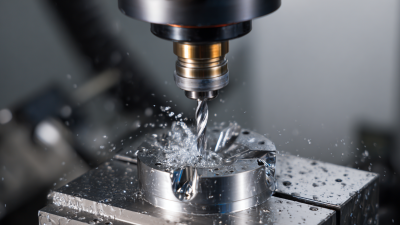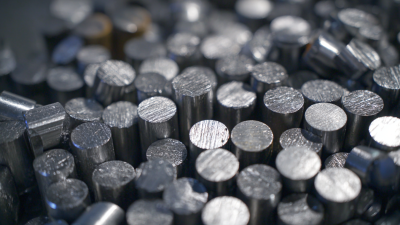How to Optimize Your Production Efficiency with Cnc Machine Inserts and Achieve 20 Percent Cost Savings
Table of Contents
- Understanding CNC Machine Inserts: Types and Benefits for Production Efficiency
- Identifying Key Metrics: Measuring Production Efficiency in CNC Machining
- Calculating Cost Savings: Analyzing the Financial Impact of CNC Inserts
- Best Practices for Selecting CNC Inserts to Maximize Tool Life and Performance
- Implementing a Performance Monitoring System for CNC Inserts: Data-Driven Approaches
- Case Studies: Real-World Examples of 20% Cost Savings through CNC Insert Optimization
- Optimizing Precision and Performance with Walter CNC Machine Tools Milling Inserts ADMT120408R-D56 WKP35
- FAQS
- Conclusion
- Related Posts
In today’s tough manufacturing world, boosting production efficiency is more important than ever if you want to stay ahead. Jinan Terry CNC Tool Limited Company, a leading player and trusted agent for exporting CNC cutting tools from China, truly understands how crucial it is to adopt cutting-edge solutions like CNC Machine Inserts. Did you know that, according to MarketsandMarkets, the global market for CNC machine tools is expected to hit $100 billion by 2025? That just goes to show how widespread CNC technology has become across different industries.

Using CNC Machine Inserts can really make a difference—improving cutting performance, extending the lifespan of tools, and cutting down on downtime. All of this adds up to cost savings of around 20%. As manufacturers push for higher productivity and efficiency, smart use of CNC Machine Inserts has become a must-have in modern production. It’s all about staying competitive in a rapidly changing market, after all.
Understanding CNC Machine Inserts: Types and Benefits for Production Efficiency
CNC machine inserts might seem like a small part of manufacturing, but honestly, they’re pretty vital when it comes to ramping up efficiency across the board. These little guys—made from stuff like carbide, ceramic, or cermet—act as cutting tools in CNC setups. They help get the job done with precision, whether it’s cutting, shaping, or finishing workpieces. According to IBISWorld, the CNC machining industry is expected to grow about 3.5% annually over the next five years. That just goes to show how much folks are leaning on advanced tools like these inserts to boost productivity and keep things running smoothly.

One of the coolest things about using CNC inserts is how much they can save a company money. A report from the International Production and Manufacturing Technologies Association (PMTA) pointed out that companies switching over to high-performance inserts can cut their overall machining costs by up to 20%. That’s pretty significant! Why? Well, longer-lasting tools mean less frequent replacements, faster cycle times, and less downtime. Plus, when you pick the right insert for the job, it just makes the entire process more efficient. So, by understanding what types of CNC inserts are out there, manufacturers can choose the best tools for their specific needs—leading to better efficiency and, hopefully, fatter profits in the long run.
Identifying Key Metrics: Measuring Production Efficiency in CNC Machining
When you're into CNC machining, keeping track of how efficiently everything's running is pretty much essential if you want to fine-tune your processes and cut down on costs. Things like cycle time, tool life, and scrap rates aren’t just numbers—they're your clues to understanding how well things are actually going. Focusing on these can help you spot bottlenecks early on and come up with smarter ways to boost productivity. For example, paying attention to how long each cycle takes can give you a better idea of where to make adjustments so your workflow flows smoother.

A good habit is to regularly check your tool life data—this way, you know exactly when it's time to swap out or sharpen those inserts. It might seem small, but it really helps reduce downtime and keeps your production quality consistent. Meanwhile, keeping an eye on scrap rates is like having a first alert system for flaws—so you can jump on issues fast and waste less material.
And don’t forget about overall equipment effectiveness, or OEE. This metric? It’s like a big picture that combines how often the machine’s available, how well it performs, and the quality of the output. When you calculate OEE, it’s easier to see what’s holding you back. For instance, if performance is lagging, maybe your machines need some TLC, or your operators could use a quick refresher. Getting familiar with these numbers isn’t just about micromanaging; it’s about creating a mindset of continuous improvement which, in the end, makes everything run more smoothly and saves you some cash.
Calculating Cost Savings: Analyzing the Financial Impact of CNC Inserts
In today’s manufacturing world, we can’t really overlook how much of a difference CNC machine inserts make on the bottom line. I’ve come across a report from the International Federation of Robotics that says using CNC tech can boost production efficiency by as much as 30%. So, swapping out old-school cutting tools for top-notch CNC inserts not only helps with precision but also cuts down on tool wear and tear. That means less downtime and steady production, which ultimately means more profits for the business.
Figuring out just how much money you save with CNC inserts isn’t as simple as it sounds – you’ve gotta look at stuff like material costs, how long it takes to machine, and maintenance bills. A study from the Journal of Manufacturing Science and Engineering found that companies who used CNC inserts more strategically saw around a 20% drop in costs, mainly because they shaved off cycle times and got better material removal. Plus, by keeping an eye on insert usage and tweaking things as you go, you can uncover even more savings. All in all, investing in good quality CNC inserts really makes sense in the long run — it’s a smart move for staying competitive and making sure the business stays profitable.
How to Optimize Your Production Efficiency with Cnc Machine Inserts and Achieve 20 Percent Cost Savings - Calculating Cost Savings: Analyzing the Financial Impact of CNC Inserts
| Dimension | Current Situation | With CNC Inserts | Cost Savings |
|---|---|---|---|
| Production Time (hours/week) | 50 | 40 | 20% |
| Material Cost ($/piece) | 5 | 4 | 20% |
| Scrap Rate (%) | 10 | 6 | 40% |
| Labor Cost ($/hour) | 30 | 25 | 16.67% |
| Overall Production Cost ($) | 2500 | 2000 | 20% |
Best Practices for Selecting CNC Inserts to Maximize Tool Life and Performance
When it comes down to boosting efficiency in CNC machining, picking the right inserts really makes all the difference. Good inserts can mean longer tool life and better overall performance, so it’s worth paying attention to what you choose. The material and shape of the insert play a huge role—they can totally change how things turn out. For example, going with tough, wear-resistant materials like carbide or ceramic can help your tools last longer, letting you run longer production cycles without constantly swapping them out. On top of that, understanding the kind of workpiece you're dealing with and the specific application can help you pick inserts with the right cutting angles and shapes, which in turn improves chip formation and reduces the forces during cutting—making everything smoother.
Another key aspect to think about is the sort of coating on the insert. These coatings can really boost performance by resisting wear better and lowering friction during cuts. Coatings like titanium nitride (TiN) or aluminum oxide (Al2O3) are pretty popular—they help your inserts last longer and give you a nicer surface finish on your parts. Don’t forget about the geometry too—different designs are better suited for different conditions, like high-speed cuts or interrupted cuts. All in all, taking the time to evaluate these factors and investing in quality inserts can save you money, while also ramping up productivity in your CNC work. It’s really about making smart choices that pay off in the long run.”
Optimization of CNC Machine Inserts and Cost Savings
This bar chart illustrates the relationship between the types of CNC machine inserts used and the corresponding production efficiency and cost savings achieved. By selecting optimized inserts, companies can enhance tool life and reduce operational costs significantly.
Implementing a Performance Monitoring System for CNC Inserts: Data-Driven Approaches
Setting up a performance monitoring system for CNC inserts is pretty much a game-changer if you're serious about boosting production efficiency and saving some serious cash. Using data to guide your decisions gives you a clear picture of how different inserts perform under various conditions. When you gather info on wear, cutting speeds, and tool life, it’s easier to figure out which inserts are actually working best for each job. This not only helps you pick the right tools but also helps plan maintenance better—you know, so you're not caught off guard with unexpected downtime.
On top of that, adding real-time monitoring tech can make a huge difference. Sensors can keep an eye on your inserts while they're in action, so if something looks off, you can jump in and fix it right away—saving you from costly failures. Looking at trends over time also helps you plan ahead, like knowing when to do maintenance or keeping just the right amount of spare parts in stock. Taking this proactive route not only makes your resource use smarter but can also cut costs by up to 20%, all while keeping your quality standards high.
Honestly, it’s about working smarter, not harder, and a good monitoring setup makes a big difference in the long run.
Case Studies: Real-World Examples of 20% Cost Savings through CNC Insert Optimization
Lately, there have been quite a few stories showing how companies are saving big bucks by fine-tuning their CNC machine inserts. You know, just tweaking their tooling setups a bit has helped some businesses cut their production costs by up to 20%. I remember reading about a manufacturer that changed up the geometry and materials of their inserts—they managed to make the tools last longer without sacrificing accuracy. That meant less downtime and less waste, which is pretty impressive. It’s a real eye-opener to see how investing in smarter CNC tech can actually pay off.
And as manufacturing keeps evolving rapidly—especially in powerhouses like China—more and more companies are turning to trusted names like Jinan Terry CNC Tool Limited for top-notch cutting tools. With all these innovations right at home, competition’s getting tighter, and optimizing production is more important than ever. By using the latest CNC insert tech, businesses aren’t just boosting efficiency—they’re also staying ahead in the game, keeping up with trends of industry growth and competitiveness.
Optimizing Precision and Performance with Walter CNC Machine Tools Milling Inserts ADMT120408R-D56 WKP35
The Walter CNC machine tools milling inserts ADMT120408R-D56 WKP35 are engineered for those who prioritize precision and performance in their machining projects. Designed with the original Walter brand's renowned craftsmanship, these milling inserts provide superior wear resistance, ensuring prolonged tool life even under rigorous working conditions. This feature makes them an excellent choice for operators seeking to enhance efficiency and reduce downtime.
These inserts are versatile, suitable for processing a wide range of materials including steel, stainless steel, cast iron, and nonferrous products. Their high-speed cutting capabilities translate into faster machining times without compromising quality, allowing for high efficiency in production environments. The design promotes stability and security during the milling process, minimizing vibrations and ensuring a smooth operation. Additionally, the high toughness and low cutting force required for these inserts further enhance their performance, making them a reliable tool for various machining applications across ISO and ANSI standards.
FAQS
: CNC machine inserts are cutting tools used in CNC machines to perform precise machining on workpieces. They can be made from materials such as carbide, ceramic, and cermet.
CNC machine inserts improve production efficiency by allowing for precise machining, which leads to reduced cycle times, longer tool life, and decreased downtime, ultimately optimizing material removal rates.
The CNC machining industry is expected to grow at an annual rate of 3.5% over the next five years, indicating an increasing dependence on advanced tools like machine inserts.
One of the primary benefits is the potential for a significant reduction in production costs, with companies achieving up to a 20% decrease in overall machining costs through the use of high-performance inserts.
Manufacturers should track metrics such as cycle time, tool life, scrap rates, and overall equipment effectiveness (OEE) to measure and enhance production efficiency.
Regular analysis of tool life data can help manufacturers determine the optimal times to replace or sharpen CNC machine inserts, reducing downtime and improving production quality.
OEE measures the combined outcomes of availability, performance, and quality, helping manufacturers identify specific areas for improvement in their operations.
Monitoring scrap rates is crucial as it can highlight flaws in the production process, enabling manufacturers to quickly address issues and minimize waste.
Tracking cycle time provides insights into how long each machining process takes, allowing for adjustments that can streamline workflows and enhance productivity.
Understanding these metrics fosters a culture of continuous improvement within the organization, contributing to enhanced efficiency and cost savings.
Conclusion
When it comes to boosting production efficiency, getting a good handle on how to optimize CNC machine inserts really makes a big difference. Knowing the ins and outs of different types of inserts, along with their perks, helps manufacturers run things smoother and get more out of their machines. Metrics like overall efficiency are super useful for figuring out just how much these inserts can save costs—sometimes by as much as 20%!
Picking the right CNC inserts is honestly a game-changer—it's all about getting the most bang for your buck in terms of tool life and performance. Plus, setting up a solid system to track how things are going allows companies to use real data to keep improving. If you look at real-world case studies, you'll see how smart insert optimization can lead to serious savings and better results.
Here at Jinan Terry CNC Tool Limited, we're proud to be a top exporter of CNC cutting tools. We totally get how important these inserts are in creating efficient, cost-effective production strategies that really work.
Related Posts
-

7 Best Tips to Maximize the Efficiency of Carbide Tool Inserts
-

Ultimate Guide to Choosing the Right Carbide Cutting Inserts for Your Projects
-

How to Select the Best Cnc Indexable Carbide Inserts Wnmg for Your Machining Needs
-

How to Select the Right PDC Blanks for Optimal Drill Bit Performance
-

How to Choose the Best High Qualiti Insert for Your Project
-

7 Unique Features of Stone Cutting Inserts You Should Know
Blog Tags:

Lila
-

Phone
-

E-mail
-

Skype

